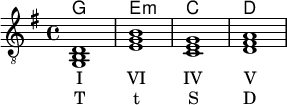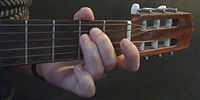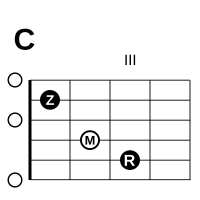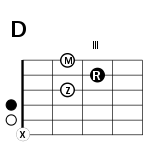Guitar/G Em C D
This page is currently being translated from Germans Wikibooks into English. • Expect some errors and inconsistencies. •Images has to be repainted. The German fingering ZMRK = imrp (Z = Index, K = small Finger = pinKy •Some German words in pictures has to be translated. • Assisted the translator because he is not a native speaker. Feel free to correct mistakes and style. • The Wikitorians among you may help me with the peculiarities of English Wikibooks. (how do you handle things, what are your preferd templates...). •delete {:Guitar/under construction - in translation}if you think the translation is largely error-free and good enough.• Be patient. The translation of the finished German lesson (links in the navigation) will take time. |
Original page translated by Google
Chord change G-Em-C-D
[edit | edit source]The Minor Parallel
[edit | edit source]The change between G major and E minor is particularly easy. By the way, memorize that E minor (written "Em" for short) is the minor parallel of G major.
In many songs you don't necessarily have to change to the minor parallel, you can simply continue to play the major chord. However, the slightly softer sounding minor chord can also replace the major chord. Minor chords are often used to make certain bars sound a little softer. It is commonly said that a minor chord sounds sad. It is true that it is relatively easy to write sad-sounding songs with minor chords, but there are also sad-sounding songs that consist mainly of major chords. Here, in most of our song examples, the minor chord serves more to build momentum for the next major chord. This allows the song to be much more spirited. Later on in the folk diploma, you will get to know songs that are written entirely in a minor key. Remember, however, that Em is the minor parallel of G major.
| Key G major with minor parallel |
|||||
Chord change G - Em - G and Em - C - Em in the diagram
[edit | edit source]Even if the individual fingering changes are quite close together here, only practise the change between two chords at first. As soon as the upper half of the diagram works, you can practise the lower half. The arrows indicate two cycles, which are first practiced separately and then later one after the other.
This position of the fingers appears very often with major chords (G C F D).
This appears in Em and Am and A major.
Chord change G-Em-C-D
[edit | edit source]- A real Schu-bi-du-ba
Chord progression G-Em-C-D is a "16-45" in G major. To designate the chord steps in a key, simply count through the notes of the corresponding scale.
- G=1, Am=2, Bm=3, C=4, D=5, Em=6, (F#m7/b5=7)
- We derive the chord degrees from the G major scale.
No panic! You don't have to learn any notes here. You should only understand how the chord steps come about. This will give you at least a rough idea of what the terms are about if you come across them in a tutorial on the Internet. You will learn all the special features of scales and chord names at a later stage.

In harmony theory, the pitches are usually given in Roman numerals.

You can assign a triad or a chord to each note and thus a chord step to each chord.

The 1st degree is called the tonic (T), the 4th degree the subdominant (S) and the 5th degree the dominant (D).

The 6th degree is called the tonic parallel (t), the 2nd degree the subdominant parallel (s) and the 3rd degree the dominant parallel (d).[1] These triads from the theory of harmony represent all the possibilities of playing a chord on the guitar.
In this way, one could play the degrees of the G major scale with simple chords.

You don't need to be interested in the unknown chords at the moment. Sooner or later you will get to know them soon enough. Today we are only interested in the first, sixth, fourth and fifth chord steps in that exact order.
- I-VI-IV-V
or
- 1-6-4-5
or shorter
- a 16-45 in G
So today we have learned about the tonic parallel E minor (Em) of the G major scale.

The chord progression is also called "50s progression" or "ice cream changes". Presumably because young people in the 50s liked to meet in an ice cream bar with a jukebox.
First practise the change G - Em - G. If this works smoothly, practise C - Em - C until this also works flawlessly. Then practise the complete chord progression G-Em-C-D.
Again, it makes sense to think of the ring and middle fingers as the "center of gravity" of the chord. This way, the teacher has no problem displaying the chords without having to announce them (leaving more time for singing or other corrections). G is at the top, D is at the bottom, Em is at the top right (as seen from the player) and C is somewhere in the middle (as it sometimes makes sense for C to be displayed a little to the left or a little to the right of the middle; see D C G).
The chord combination is a regular cycle that is very easy to memorize and therefore very easy to learn.
Audio sample
[edit | edit source]- One chord for two bars

- One chord per bar

- ↑ These terminology is more common in most Germanic and Slavic languages. In Romance languages you have called the 6th degree submediant, the 2nd degree supertonic and the 3rd degree mediant. But this will not help you to remember that the natural scale of E minor and the natural scale of G major have the same notes. Or that the fingering of the G major pentatonic is the same as the E minor pentatonic.




























